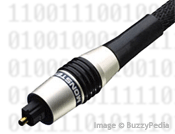The most widely used Digital Surround sound formats today are
Dolby Digital 5.1 and
DTS 5.1. Both formats are similar to each other and it's again a matter of personal taste which you prefer. Both formats have 5 separate audio channels (the "5") and have a separate channel for your subwoofer for the very low frequencies (the ".1"). The subwoofer channel is actually optional and can be switched off since you can have the low frequencies of the sound sent to the other 5 channels. Low frequencies require huge speakers and the idea behind a subwoofer is that since you can't tell exactly where a low frequency sound is coming from anyway, it doesn't matter where the source for these low frequencies is. This enables you to use 5 very small speakers for the 5 main channels, and one big subwoofer, which you can hide out of sight. Even though the theory is correct, I personally don't care for a separate subwoofer since there's one major flaw. Even though you can't hear
where it's coming from, you can hear if you are
farther or
nearer to the source. This means that no two people in the same room listening to the same sound source are hearing the subwoofer at the same volume. So for one person the bass volume can be way too low, while for another it's overwhelming. The result is always that there's only one "sweet spot" in your room where the sound and volume is "just right".

The best method to send the sound information to your Audio Receiver is digitally of course (since it's digital data to begin with). However, some DVD players split the signal to 6 separate analog channels first before sending it out. Besides the fact that this means you have 6 wires going to your audio receiver, the disadvantage is that it's analog and prone to interference. Another disadvantage is that hardly any receiver supports this option (6 analog inputs for a single incoming surround signal). So beware that even though some DVD players claim to support Dolby Digital and/or DTS, make sure it's actually sent digitally to your receiver.
But again, the story does not stop here. There are two methods used for transporting the digital data to your receiver. By means of an
optical cable, or by means of a
coaxial cable. Both have their advantages and disadvantages, but none of the disadvantages will result in a worse quality sound. It can however result in sound cutting out all together every now and then. Which method is preferred depends on the DVD player's environment. Since optical cables are made of
glass, they can actually break inside. But information is transported as light and there isn't much that can interfere with that and it can be transported over longer distances. Coaxial cables are much stronger but the digital information is sent as an electrical signal, which is sensitive to interference. If your DVD is within 3 feet of your receiver, it really doesn't matter which cable you use. When your DVD player is on the other side of the room from your receiver, then it depends on how you will run the cable. But, this entire discussion is moot when the used method of your receiver doesn't match up to your DVD's. If your DVD has optical out only while your receiver only has coaxial in, there's no way you can hook the two up digitally without using
very expensive converters.
Copyright © 2006 - BuzzyPedia.com

